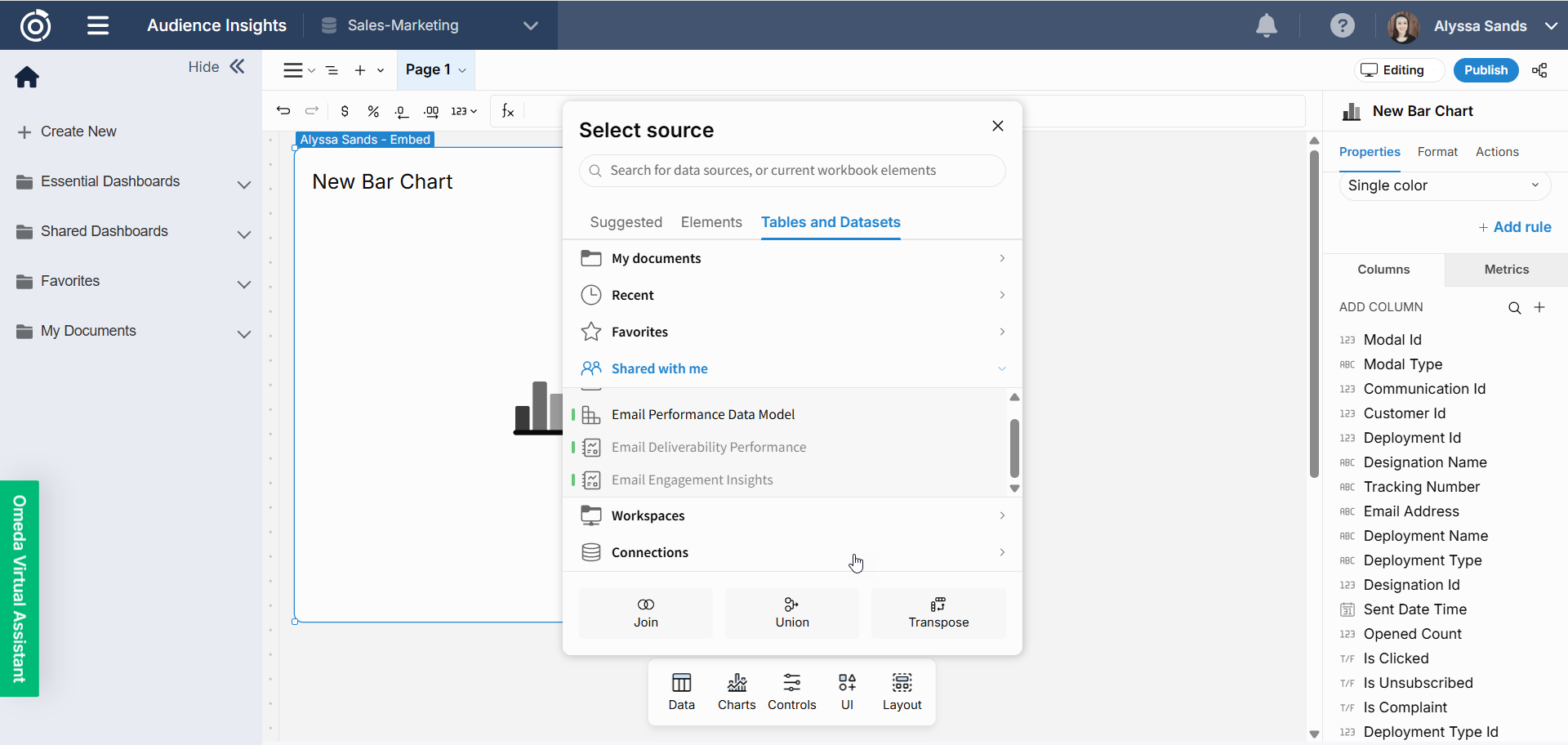Understanding Data Sources
User Agent Metadata
Columns | Type | Description |
|---|---|---|
Customer Id | Number | Unique identifier for a customer in the Omeda database. |
Customer Behavior Visit Id | Number | Unique identifier for a specific visit or interaction instance. |
Behavior Name | Text | The name of the Olytics-defined behavior triggered during the visit. |
Visit Date | Date | The timestamp when the visit occurred. |
Browser | Text | Browser type derived from the user agent string. Useful for identifying technical constraints or trends by platform. |
Device | Text | Device category (e.g., Desktop, Mobile, Tablet) as inferred from the user agent. Helps analyze engagement patterns by device. |
OS | Text | Operating system used during the visit, supporting segmentation by technology environment. |
Referring Domain | Text | The origin domain that referred the visitor (e.g., Google, newsletter). Helps evaluate traffic sources and attribution. |
Modal Id | Number | Unique ID linking a dashboard action with Audience Builder. Required to enable direct "Send to Audience Builder" from dashboards. |
UTM Parameter Values
Columns | Type | Description |
|---|---|---|
Customer Id | Number | Unique identifier for a customer in the Omeda database. |
Customer Behavior Visit Id | Number | Unique identifier for a specific visit or interaction instance. |
Behavior Name | Text | The name of the Olytics-defined behavior triggered during the visit. |
Visit Date | Date | The timestamp when the visit occurred. |
Parameter Name | Text | The UTM parameter key captured during the visit (e.g., utm_source, utm_medium). Used to analyze marketing attribution and campaign performance. |
Parameter Value | Text | The corresponding value assigned to the UTM parameter (e.g., newsletter, social). Helps trace traffic sources, understand user acquisition paths, and segment audience behavior by campaign. |
Modal Id | Number | Unique ID linking a dashboard action with Audience Builder. Required to enable direct "Send to Audience Builder" from dashboards. |
Page Engagement
Columns | Type | Description |
|---|---|---|
Customer Id | Number | Unique identifier for a customer in the Omeda database. |
Customer Behavior Visit Id | Number | Unique identifier for a specific visit or interaction instance. |
Behavior Name | Text | The name of the Olytics-defined behavior triggered during the visit. |
Visit Date | Date | The timestamp when the visit occurred. |
Visitor Type | Text | Classification of the visitor as either known (identified via email, login, or subscription data) or unknown (anonymous web activity). |
Base URL | Text | The full URL path (excluding query parameters) of the page visited. Useful for content performance analysis and filtering by page category. |
Modal Id | Number | Unique ID linking a dashboard action with Audience Builder. Required to enable direct "Send to Audience Builder" from dashboards. |
Attribute Data
Columns | Type | Description |
|---|---|---|
Customer Id | Number | Unique identifier for a customer in the Omeda database. |
Customer Behavior Visit Id | Number | Unique identifier for a specific visit or interaction instance. |
Behavior Name | Text | The name of the Olytics-defined behavior triggered during the visit. |
Visit Date | Date | The timestamp when the visit occurred. |
Attribute Type Name | Text | The name of the behavioral or contextual attribute captured during the visit (e.g., Olytics Category, Olytics Tag). Used to enrich visit data with marketing, content, or audience metadata. |
Attribute Value Name | Text | The value associated with the captured attribute (e.g., article, organic, sports). |
Modal Id | Number | Unique ID linking a dashboard action with Audience Builder. Required to enable direct "Send to Audience Builder" from dashboards. |
Refresh Date
Columns | Type | Description |
|---|---|---|
Data Refresh Date | Date | The date the dashboard data was last refreshed. |
Subscriptions Data Model
This data model includes the fields necessary to analyze magazine subscriptions. The data model has several elements:
Subscription Customer Data
Columns | Type | Description |
|---|---|---|
Customer Id | Number | Unique identifier for a customer in the Omeda database. |
Verification Date | Date | Date the most recent subscription documentation or confirmation was received from the subscriber. Validates the recency and compliance of the subscription. |
Changed Date | Date | The current format the subscriber is receiving their subscription in. eg Print, Digital, Both. |
Active Version | Text | The current format of the subscription delivery, e.g., "Print", "Digital", or "Both". |
Payment Status | Text | Billing classification of the subscription, such as "Controlled", "Paid with Order", "Credit", or "Free Term". |
Quantity | Number | Number of subscription units associated with this record (typically 1 unless a bulk or group subscription). |
Subscription Type | Text | Indicates whether the subscription is a first-time subscription ("Add") or a renewal. |
Renewal Code | Text | Instructions for renewal treatment. For example, "No Renewal" signals exclusion from renewal campaigns. |
Class Definition | Text | Subscription classification code that determines the active/inactive status. Examples include:
|
Source | Text | Origin or method of acquisition for the subscription. |
Payment Status Category | Text | Simplified description of whether the subscription is paid or non-paid, derived from Payment Status. |
Paid | Number | Numeric flag where 1 indicates the subscription is paid. |
Non Paid | Number | Numeric flag where 1 indicates the subscription is non-paid. |
Product | Text | The name of the subscribed product (e.g., magazine or digital publication title). |
Modal Id | Number | Unique ID linking a dashboard action with Audience Builder. Required to enable direct "Send to Audience Builder" from dashboards. |
Renewal Data
Columns | Type | Description |
|---|---|---|
Customer Id | Number | Unique identifier for a customer in the Omeda database. |
Product | Text | The name of the subscribed product (e.g., magazine or digital publication title). |
Active Version | Text | The current format of the subscription delivery, e.g., "Print", "Digital", or "Both". |
Class Definition | Text | Subscription classification code that determines the active/inactive status. Examples include:
|
Source | Text | Origin or method of acquisition for the subscription. |
Group Category | Text | Indicates whether the subscription is held by an individual or part of a group account. |
Expire Issue Name | Text | The name of the issue corresponding to the expiration of the subscription, typically formatted as YYYYMM. |
Expire Date | Date | The scheduled date when the subscription will expire. Used for renewal forecasting and campaign planning. |
Expire Year | Number | The year portion of the subscription expiration date. Useful for year-over-year reporting or cohort analysis. |
Expiring - Add | Number | Numeric flag where 1 means the subscription is expiring and is a first-time (Add) subscription. |
Expiring - Renewal | Number | Numeric flag where 1 means the subscription is expiring and has been renewed previously. |
Renewed - Add | Number | Numeric flag where 1 means the subscription was renewed and this is the subscriber's first renewal. |
Renewed - Renewal | Number | Numeric flag where 1 means the subscription was renewed and the subscriber had previously renewed. |
Not Renewed - Add | Number | Numeric flag where 1 means the subscription was not renewed, and it was a first-time (Add) subscription. |
Not Renewed - Renewal | Number | Numeric flag where 1 means the subscription was not renewed, and it had previously been renewed. |
Modal Id | Number | Unique ID linking a dashboard action with Audience Builder. Required to enable direct "Send to Audience Builder" from dashboards. |
Demographic Data
Columns | Type | Description |
|---|---|---|
Customer Id | Number | Unique identifier for a customer in the Omeda database. |
Demographic Name | Text | The label or type of the demographic attribute (e.g., Job Title, Industry, Company Size). |
Demographic Value | Text | The subscriber-specific value assigned to the Demographic Name (e.g., Editor, Healthcare, 100-499 employees). |
Active Version | Text | The current format of the subscription delivery, e.g., "Print", "Digital", or "Both". |
Product | Text | The name of the subscribed product (e.g., magazine or digital publication title). |
Class Definition | Text | Subscription classification code that determines the active/inactive status. Examples include:
|
Source | Text | Origin or method of acquisition for the subscription. |
Modal Id | Number | Unique ID linking a dashboard action with Audience Builder. Required to enable direct "Send to Audience Builder" from dashboards. |
Account Data
Columns | Type | Description |
|---|---|---|
Customer Id | Number | Unique identifier for a customer in the Omeda database. |
Product | Text | The name of the subscribed product (e.g., magazine or digital publication title). |
Active Version | Text | The current format of the subscription delivery, e.g., "Print", "Digital", or "Both". |
Class Definition | Text | Subscription classification code that determines the active/inactive status. Examples include:
|
Source | Text | Origin or method of acquisition for the subscription. |
Earning Date | Date | The date the revenue was recognized from the subscriber’s transaction. |
Amount | Number | The monetary amount of recognized earnings from the subscriber. |
Issue Name | Text | The name of the issue for which the earnings were recorded, typically formatted as YYYYMM. Supports period-based revenue analysis. |
Earning Account | Text | The internal financial account (e.g., department, GL code) to which the earnings are attributed. |
Modal Id | Number | Unique ID linking a dashboard action with Audience Builder. Required to enable direct "Send to Audience Builder" from dashboards. |
AI Tagging Data Model
This data model includes the fields necessary to analyze AI Powered Content Tagging data. The data model has several elements:
Tag Table
Columns | Type | Description |
|---|---|---|
Customer Id | Number | Unique identifier for a customer in the Omeda database. |
Content Type | Text | Indicates the source of the content tag interaction, such as “Email” (from campaign deployments) or “Web” (from tagged pages via CDP). |
Category | Text | The content tagging category that groups the tag under a shared dimension (e.g., Context, Tone, Industry, Job Title, etc.). These are the AI-defined dimensions generated during content analysis. |
Tag | Text | The specific tag value assigned within a category—for example, "Casual" under Tone or "Healthcare" under Industry. |
Engagement Level | Text | Qualitative measure reflecting the user's level of interaction with content carrying this tag. Represents how recently and frequently the tag has been engaged. |
Affinity Level | Text | Qualitative score of how strongly a user aligns with or prefers content associated with this tag, based on their behavior in the last 90 days. |
Tag Engagement Weight | Number | Quantitative score indicating the user’s relative engagement intensity for the given tag. |
Tag Affinity Weight | Number | Quantitative score showing the user’s overall affinity for the tag over time. |
Modal Id | Number | Unique ID linking a dashboard action with Audience Builder. Required to enable direct "Send to Audience Builder" from dashboards. |
Additional Resources
View Dashboards Documentations
Learn how to access, navigate, and interpret dashboards in Audience Insights.Create and Edit a Dashboard
Learn how to access, navigate, and interpret dashboards in Audience Insights.Explore Training and Documentation from Sigma
Dive deeper into advanced features and capabilities with our analytics engine partner, Sigma Computing.Audience Insights Overview
Understand how Audience Insights fits into the broader Omeda platform and what makes it different.

